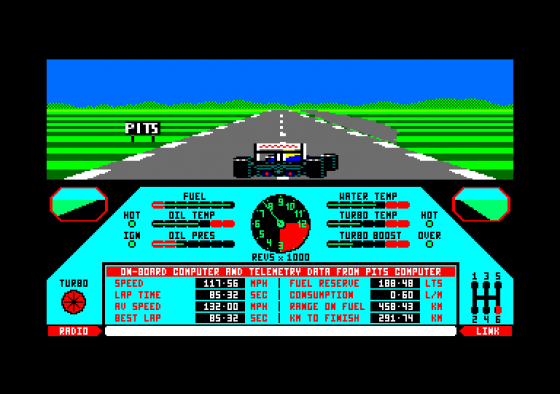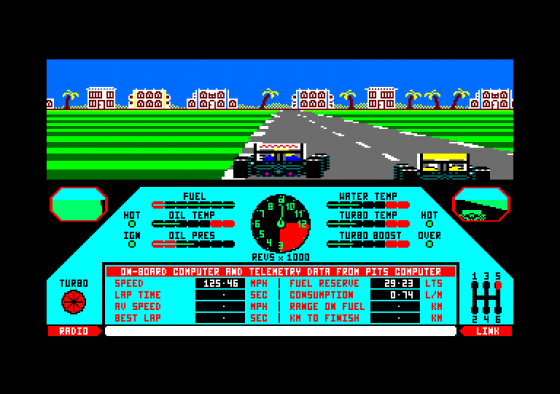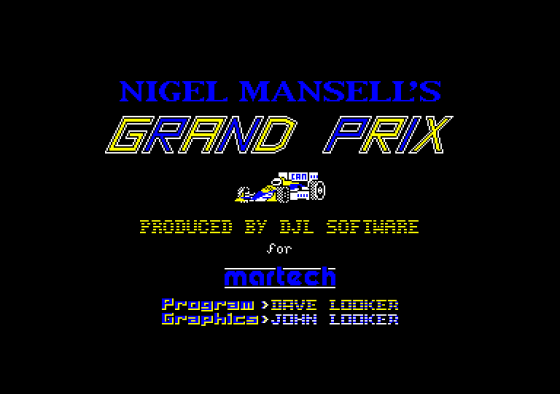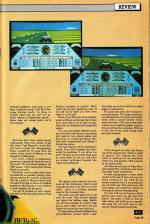
Amstrad Computer User
 1st December 1987
1st December 1987
Categories: Preview: Software
Author: Simon Rockman
Published in Amstrad Computer User #37
Neeeyaaaaaaaah, the new game from Martech roars on to the screens. And as Murray Walker would say, if it comes first it'll be a winner. Simon Rockman takes his place on the grid (in the pits more like).
Nigel Mansell's Grand Prix
Racing is complicated. It taxes engineering, mechanics and teamwork to the utmost. Most of the motor racing games up to now have concentrated on driving the car. Following the right line around bends, overtaking in the right place. Only Revs, which lamentably is not available for the Amstrad, has done a really good job of that. But Revs was a Formula 3 game. Once you start to mess with Formula 1 things get ten times as complicated (and 50 times as expensive!).
The driver is part of a team, he must cooperate to win the race. Initially there are tyre and suspension settings to worry about. Wing tolerances and on the Honda-powered Williams active suspension.
A race lasts two hours or 70 laps - whichever is the shorter. Cars can have new tyres fitted but for safety reasons they are not allowed to refuel. The maximum size of the petrol tank is limited by regulations. The result is that if you go too fast early on in the race you are likely to run out of petrol before you see the chequered flag.

David Looker of DJL Software has been handed the task of writing Martech's Nigel Mansell's Grand Prix for the Amstrad. He appreciates it is no easy task to get this game into 64k.
David and Martech also appreciate that it is easy to make the game too sophisticated for the majority of players. To placate the meek there is a simplified version without any of the technical problems. Just jump in and blast 'round the track. A bit like Playscape karting really. (A place in London where you can race real gokarts indoors at frightening speeds - better than any arcade game you've ever played).
Real men don't want namby-pamby video games. They want realism. To get this from Nigel Mansell's Grand Prix, you have to enter the championship. Brace yourself for sixteen races, from the twisty street circuit of Monaco to the straights of Silverstone.

You enter a battle of gladiatorial proportions against the finest drivers in the world. The circuits are based on the 1987 season, which means that Brands Hatch is excluded.
David has tried to make each circuit as authentic as possible; memory limitations restrict the number of features like the tunnel at Monaco. Each track is loaded from tape or disc so it would be possible to add circuits or even produce a track designer for the game.
You get to practice on each circuit, and then in the immortal words of Pole Position "prepare to qualify". Each track has its own qualifying time. If you fall too far short you won't even make it to the grid. Those of you who are hot on multiplication will have worked out that sixteen two hour races take a lot of time to play. Only the over-dedicated will accept this option.

You can save games between races, but even then two hours at one sitting will result in very sweaty palms, and dare I say it, a bored expression. Martech have compromised and offered a limited lap option. The fuel capacity will be trimmed to match. Even with limitless fuel, there would be problems if you drove too hard. Turning up the turbo boost puts an extra strain on the car, and there are always unforseen hazards like wheel nuts falling off.
The display looks cluttered, but contains all the information which would normally be sent to the driver over the radio - there is a scrolling message area for the transient data.
The radio may well signal you to pit stop for tyres. This should happen just before the halfway stage. Ideally you will have enough of a lead to stop, put on new rubber and leave the pits before the second car can catch you.

Pit stops had not been included in the pre-production version which I saw. Once they are in there will be an added degree of excitement.
The game uses some clever programming techniques. The mode and palette are split between the track and cockpit views, with a second palette switch above the track. This means that eight colours can be used for palette rotation thus smoothing the animation. With up to four cars or the track things could get quite crowded.
Turbo charged cars often spit flames out of the exhaust pipe. This is a result of unburnt fuel entering the turbo which is glowing red or sometimes white hot, and igniting. This is shown in the screen shots.

As befits the accuracy of Nigel Mansell's Grand Prix, the flames only shoot out under harsh acceleration.
In most racing games a major crash results in the loss of time and your car being returned to the track by an unseen mystical hand. If you prang, you are out of the race. This means you will loose points and stand less chance of winning the drivers championship.
It is how well you do this year which governs how much you get paid next season. The game is fixed so that no other driver will build up an unassailable lead, but you can't rest on any laurels. Britain needs that trophy!
This article was converted to a web page from the following pages of Amstrad Computer User #37.





